Chef Komoda’s Fermented Seasonings for Sichuan Cuisine
Mar 30,2023
Chef Komoda’s Fermented Seasonings for Sichuan Cuisine
Mar 30,2023


Komoda Kinya is a star Sichuan-cuisine chef, whose friendly manner has made him a familiar sight in living rooms around the country. Every year, in early summer, he prepares 160 kilograms of doubanjiang (spicy Chinese bean paste). However, the fermented foods he makes on his own do not end with doubanjiang. On his days off, he goes into the kitchen by himself and makes karasumi dried mullet roe and mentaiko spicy cod roe, proving he is a genuine fermenter! We pressed Komoda for why he so fascinated by fermentation.
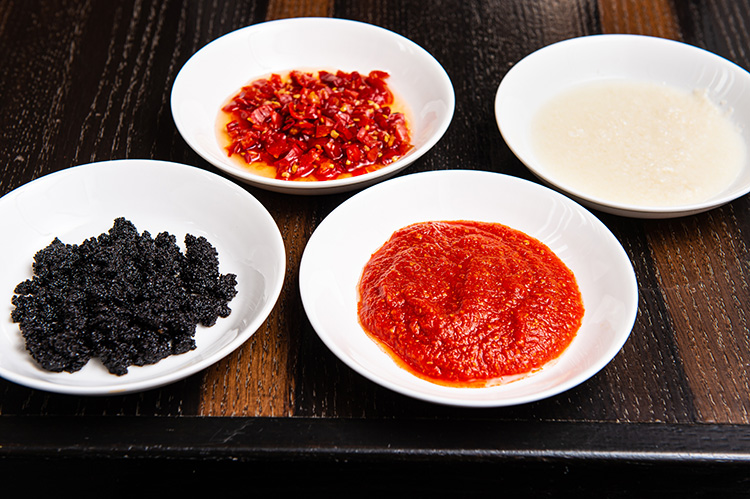
From the left: Chopped and stir-fried douchi fermented black beans, fermented and pickled chili peppers, commercially produced doubanjiang, and Komoda’s own homemade jiuniang
“Alongside doubanjiang, another seasoning frequently found in Sichuan cooking is pickled chili peppers, known as pao la jiao.
“In the past, chili peppers, freshwater fish, and salt were fermented together. The most common method today, however, is fermenting just the chili peppers and salt and leaving out the freshwater fish.
“One signature dish that features pao la jiao is yuxiang qiezi. This dish is the origin of what has become well known in Japan as mabo nasu [eggplant stir-fry with Chinese chili sauce]. The name yuxiang qiezi, which literally means fish-fragrant eggplant, suggests that long ago, chili peppers fermented with freshwater fish were used to add the umami and aroma of fish to eggplant.
“If you add pao la jiao to soup and heat them up together, the umami from the chili peppers continues to bloom and expand. The soup will be clear, but spicy. It will be spicy, but not just spicy. The soup’s complex flavor is an artform performed by the power of fermentation.
“Other common seasonings include douchi, which is made from fermented soybeans, and jiuniang, which is made from koji malt and glutinous rice. Jiuniang is not available commercially, so I make my own.”
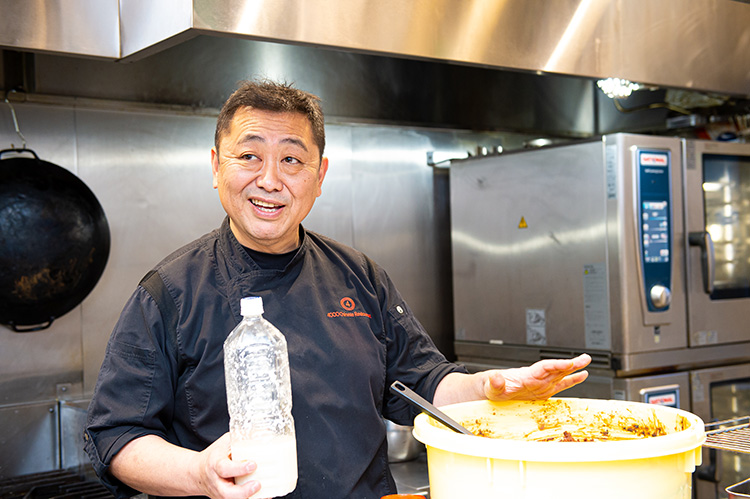
The PET bottle contains Komoda’s homemade jiuniang
“Sugar is very frequently used as a seasoning in Chinese cooking. For instance, even a dish like stir-fried prawns in salt actually uses more sugar than salt.
“The reason for this is that the zone in which we perceive salt to be delicious is quite narrow. Salt’s delicious zone lies within the very tiny gap between salty and lightly flavored. But if you add in some sweetness, you can instantly expand this delicious zone.
“Sugar’s sweetness, however, is very straightforward and easy to detect. If you use a sweet fermented seasoning like jiuniang or amakoji [a sweet drink variant of amazake made from 100-percent rice koji] instead of sugar alone, you can craft a more complex and mellower sweetness. With this method, the saltiness doesn’t hit your tongue directly, so you have time to slowly savor all five basic tastes. This is just my intuition, and I’m not sure if it’s theoretically correct. But I am certain that the sweetness of fermentation is milder than that of sugar.”
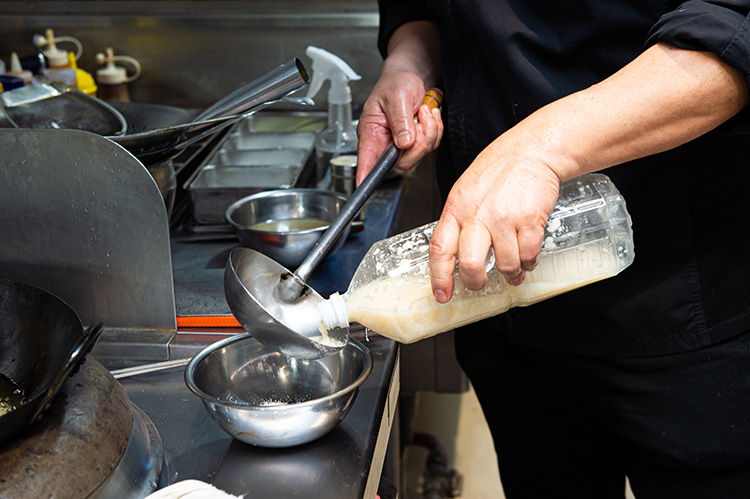
Preparing a seasoning mixture by adding jiuniang
“Jiuniang is made by fermenting koji, sugar, and saké and then kneading in steamed glutinous rice. The trick is to let the steamed glutinous rice cool down to around skin temperature before adding it in. If you add steamed glutinous rice while hot, it will kill off the bacteria. The finished jiuniang is essential to my cooking, whether I’m adding it to shrimp chili or to a seasoning mixture for a stir-fry dish. Its mellow, sweet and sour taste is my go-to secret flavor.”

Add a few drops of amakoji when reconstituting dried shark’s fin
“At my restaurant, we use amakoji when reconstituting dried shark’s fin. With stews like shark’s fin, if you use a lot of sugar, the sweetness will be almost overpowering. In this respect, amakoji’s milder sweetness harmonizes well with other seasonings. This is a recent discovery that blew me away when I tried it.”
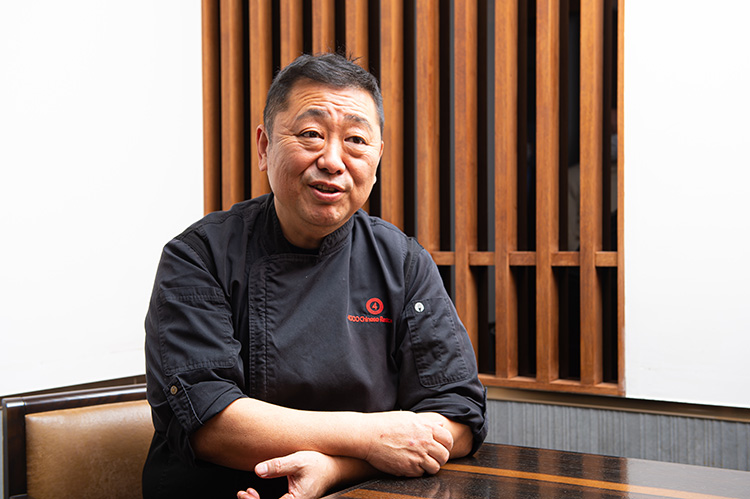
“I make doubanjiang, I make jiuniang, and I make karasumi and mentaiko too. I serve the karasumi in my restaurant, but the mentaiko is just a hobby. (laughs)
“I got into mentaiko when I went to a sushi restaurant that served it and I happened to ask the chef whether it was possible to make it at home. He told me it was very hard, and that’s what lit my fire. I thought, ‘How difficult can it be? I’ll give it a go.’
“The way I make it is completely my own. I don’t know if it’s the right way, but I freeze the cod roe and pickle it in salt. It takes about two weeks until it’s ready. At first, I chose large, attractive looking cod roe, but now I’m more deliberate about picking high quality cod roe regardless of its size. When the restaurant is closed, I’ll go in and prepare some five kilograms of mentaiko. Even I think I’m crazy.”

“I take the finished mentaiko, cut it into bite-sized pieces, sprinkle some saké on it, and lightly steam it. When it’s done, it’s fantastic. It’s incredibly aromatic and fluffy, raw on the inside and crispy on the outside. Pour the entire thing over rice, including the broth from the saké, and try it. It’s to die for.
“When December comes around, I make karasumi. What sets my karasumi apart is that the center is a little raw with a firm egg texture. I’ve experimented freely with it, like adding in some sourness with apple vinegar, and made many different patterns of karasumi. Since it doesn’t need to be preserved, I use as little salt as possible. I feel that if there is too much initial saltiness, then the umami is hard to taste. I’m particular about how much salt I use in my fermented foods, and it’s something I’m still studying.”
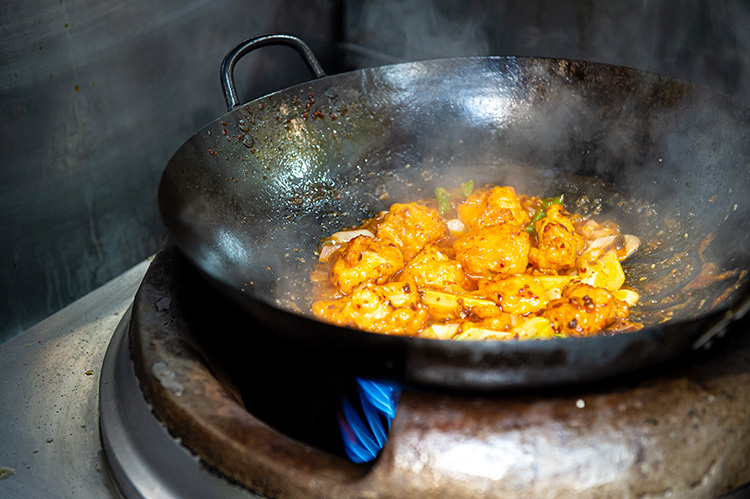
Quickly locking in the ingredients’ flavors at their absolute best
“When I make doubanjiang, jiuniang, karasumi, and other fermented foods, I’m always reminded that fermentation is possible only because of the actions of living bacteria, and that time is an absolute requirement for the fermentation process.
“Cooking, conversely, has to be done quickly in order to lock in the ingredients’ absolute best flavor. What gives a sense of depth to food that is cooked quickly is fermented ingredients. I think it’s the time, the labor, and the process involved in the fermentation and maturation. Even with a salty sauce, for example, there’s a big difference in the depth of flavor between something made with salt, sugar, and oil and something that includes a few fermented seasonings as well.
“Using the seasonings and techniques I learned in Sichuan, I want to use the abundant ingredients of Japan in the most delicious way possible in my cooking. That’s the kind of restaurant I want to have.
“When I think about what my customers who come to eat my cooking are looking for, I guess it’s that I continually strive for what’s truly delicious. I experiment without preconditions, whether I use Sichuan seasonings, Japanese seasonings, or my own homemade seasonings. More than anything, I want to be honest in my selections of ingredients, including seasonings. I make food that goes into my customers’ bodies, and they entrust me to select ingredients on their behalf. I keep these things in mind as I try to push forward.”
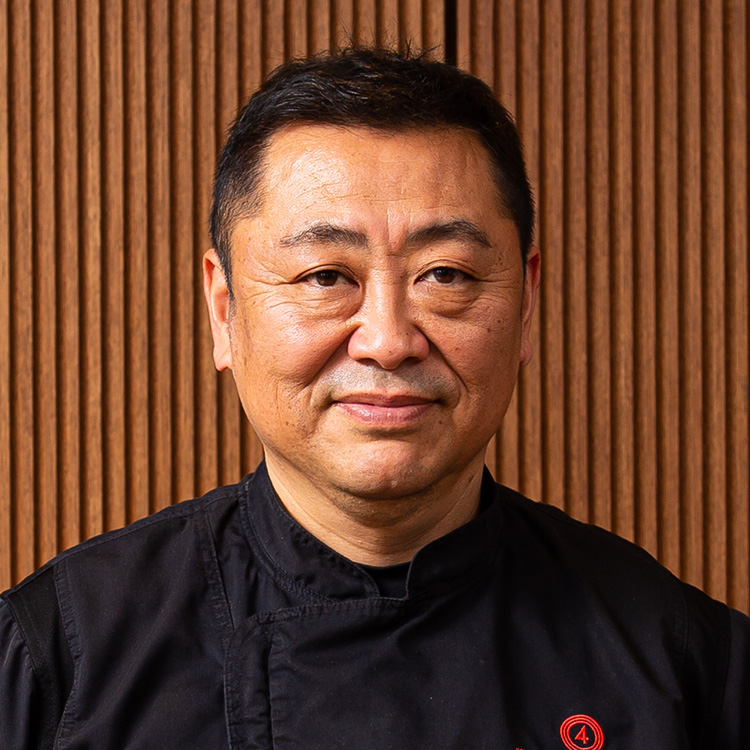
After graduating from the Osaka Abeno Tsuji Culinary Institute, Komoda joined the Akasaka Shisen Hanten Group in 1988. He trained under Chef Chen Kenichi and continued to support the Group for about 30 years, including serving as the Executive Chef of the Szechwan Restaurant Division. He struck out on his own and opened the hot-pot specialty restaurant Fire Hall 4000 in 2017, and in 2018, he opened the 4000 Chinese Restaurant in Minami Aoyama. Komoda is committed to communicating the joy and attractions of food and to educating future generations, appearing on TV, in magazines, and at events and teaching at culinary schools. He has published Komoda Kinya’s Book on Becoming A Master Chinese Chef among other titles.
https://komoda.amebaownd.com/
4000 Chinese Restaurant